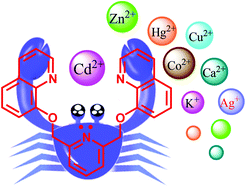A simple fluorescent probe for Cd2+ in aqueous solution with high selectivity and sensitivity†
Abstract
A simple

* Corresponding authors
a
Shanghai Key Laboratory of Chemical Biology, State Key Laboratory of Bioreactor Engineering, School of Pharmacy, East China University of Science and Technology, Shanghai, China
E-mail:
xhqian@ecust.edu.cn
Fax: +86 21 6425 2603
Tel: +86 21 6425 3589
b
Shanghai Key Laboratory of Green Chemistry and Chemical Processes, Department of Chemistry, East China Normal University, 3663 N. Zhongshan Road, Shanghai, China
E-mail:
hbyang@chem.ecnu.edu.cn
A simple

 Please wait while we load your content...
Something went wrong. Try again?
Please wait while we load your content...
Something went wrong. Try again?
L. Xu, M. He, H. Yang and X. Qian, Dalton Trans., 2013, 42, 8218 DOI: 10.1039/C3DT50216C
To request permission to reproduce material from this article, please go to the Copyright Clearance Center request page.
If you are an author contributing to an RSC publication, you do not need to request permission provided correct acknowledgement is given.
If you are the author of this article, you do not need to request permission to reproduce figures and diagrams provided correct acknowledgement is given. If you want to reproduce the whole article in a third-party publication (excluding your thesis/dissertation for which permission is not required) please go to the Copyright Clearance Center request page.
Read more about how to correctly acknowledge RSC content.
 Fetching data from CrossRef.
Fetching data from CrossRef.
This may take some time to load.
Loading related content
